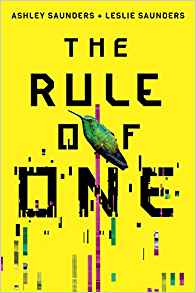The Rule of One
- By Ashley and Leslie Saunders
- Skyscape
- 270 pp.
- Reviewed by Diana Towner
- December 31, 2018
In the near future, “twins” are forced to flee through a post-apocalyptic America.

Twin sisters Mira and Ava Goodwin are alike in every way, down to how they dress and talk.
They have to be.
In a near-future, dystopian United States, where each family is only allowed one child due to a shortage of natural resources, Mira — the second born of the sisters — lives a hidden life. The two girls alternate roles: One goes to school while the other stays hidden in a basement; the next day, they switch.
When the girls’ father, the head of the Texas Family Planning Division, hosts a dinner for the governor, however, Mira’s identity is discovered, and the twins are forced to flee.
Ava and Mira leave their home and, with it, their sheltered, regimented life. As they journey from Texas to Colorado and beyond, the girls discover an underground network of revolutionaries and drifters, straggle across deserted neighborhoods and barren wasteland, and witness instances of police brutality and violence committed by highway robbers.
Meanwhile, whispered messages to “save the twins” wind along the rebellious underbelly of American society.
Along the way, Ava and Mira’s world shatters, forcing them to confront grim realities from which their father’s government position had shielded them. As they disguise themselves to avoid detection, they also discover that — try as they might — they are not the same person. For once, their separate identities are recognized.
Mira is especially affected by the change of circumstance; after posing as Ava for years, she is at last her own person, and she struggles to assert herself. Tension between the sisters grows, and after a bitter argument, they temporarily part ways.
Authors (and real-life sisters) Ashley and Leslie Saunders portray a plausible near-future; they describe facial-recognition technology, brutal police units, and powerful water filters in a place where clean water is scarce. These details, along with mentions of a tense political climate, build a realistic world that makes sense and reinforces the setting’s dystopian conditions.
Though the setting of The Rule of One is intricate and varied, the protagonists are less so. For the sake of their survival, the twins have been raised to be as identical as possible. Unfortunately, this shows in the writing style. Chapters alternate perspectives between Ava and Mira, and though the girls gradually edge toward their own unique identities, their voices sound essentially the same, to the point where it is occasionally difficult to tell who is narrating.
The prose is lackluster, too; characters miraculously read each other’s thoughts, understanding one another without thinking and answering unspoken questions aloud. In one scene, Ava has a conversation with Mira and calls it “twinspeak.” Yet this plain, quick writing style keeps the action moving along. Each scene pulls the plot forward, and each chapter ends on a compelling note.
The Rule of One is a narrative whirlwind with a lot to say — about the state of today’s politics, about the amount of power lent to the government, about how a nation deals with catastrophe and the people who are its collateral damage — yet it spells it out pedantically on the page.
In one scene, Mira muses on the name of the school she attends:
“[The governor’s] own grandmother founded Strake, naming the university after a part mounted on aircraft that improves aerodynamic stability. Meaning students are simply parts on a machine to make Texas soar.”
The novel is overly eager to point out its themes and symbolism. In doing so, it fails to allow readers to interpret the text for themselves.
Diana Towner is studying creative writing and animation at the University of Maryland, Baltimore County.
